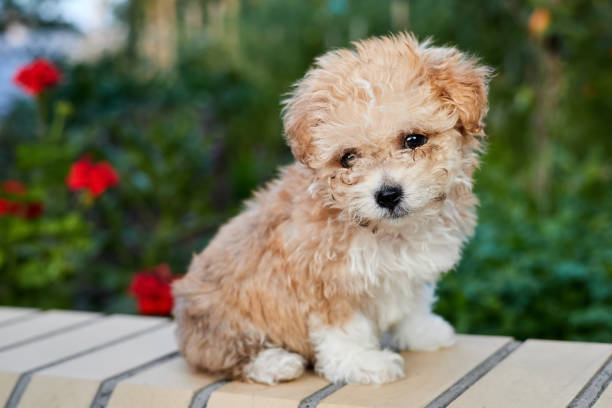Maltipoo

Breed History:
The Maltipoo is a popular hybrid dog, created by crossing the Maltese with the Toy or Miniature Poodle. This designer breed emerged in the late 20th century, bred primarily for companionship and to combine the best traits of both parent breeds — the Maltese’s gentle and affectionate nature with the Poodle’s intelligence and hypoallergenic coat. Maltipoos quickly gained popularity as loving family pets and therapy dogs, especially valued for their friendly demeanour and manageable size.
Although not recognised as an official breed by major kennel clubs, the Maltipoo is widely cherished as a companion dog. Their adaptable nature and sociable temperament make them perfect for apartment living and families seeking a small, low-shedding pet.
|
Gender |
Height |
Weight |
|
Male |
20–35 cm |
2.5–5.5 kg |
|
Female |
20–33 cm |
2.5–5 kg |
Size – Small
Life Expectancy: 12–15 years

Breed Appearance:
Maltipoos vary widely in appearance due to their mixed heritage but typically have a soft, curly to wavy coat that is low-shedding and hypoallergenic. Coat colours range from white and cream to apricot, tan, and various mixes. Their expressive dark eyes and button-like nose give them a cute, teddy bear-like face.
This small breed has a compact, sturdy body with floppy ears and a plumed tail that often curls over the back. Their size and adorable looks make them very popular as companion pets.
Breed Type – Family/Companion:
Maltipoos are affectionate, friendly, and highly social dogs that thrive on human interaction. They are excellent companions for families, singles, and seniors alike. Their playful and gentle nature makes them good with children and other pets, though supervision is recommended due to their small size.
These dogs crave attention and often bond strongly with their owners, sometimes following them around the house. They are not suited for long periods of solitude and may develop separation anxiety if left alone too long.

Training:
Maltipoos are intelligent and eager to please, which usually makes training relatively straightforward. Positive reinforcement techniques, such as treats and praise, work best. Early socialisation and gentle, consistent training help shape their behaviour and prevent small dog syndrome tendencies like excessive barking or stubbornness.
They learn quickly but require mental stimulation to avoid boredom. Training should be fun and engaging to keep these sensitive dogs motivated.
Health & Care:
Generally healthy, Maltipoos can still be prone to health issues common to their parent breeds, including patellar luxation, progressive retinal atrophy (PRA), dental problems, and allergies. Routine veterinary care, a balanced diet, and regular exercise are important.
Their small size means they are less prone to joint problems, but care should be taken to avoid injury from falls or rough handling.

Living Conditions:
Maltipoos are well-suited to apartment and city living due to their small size and moderate exercise needs. They enjoy indoor play and short daily walks but benefit from interactive toys and activities that stimulate their minds.
They prefer being close to their family and are happiest in homes where they receive plenty of attention and affection.
Exercise:
Moderate exercise needs can be met with daily short walks and indoor play sessions. Maltipoos enjoy games like fetch or puzzle toys that engage their intelligence. Overexertion should be avoided due to their small size.
Keeping them active helps prevent obesity and supports their overall health and happiness.
Grooming:
Maltipoos require regular grooming to prevent mats and tangles, with brushing recommended several times a week. Their coat may be clipped every 6–8 weeks, depending on the owner's preference. Bathing should be done as needed with gentle shampoo.
Regular dental care is crucial to prevent dental disease, common in small breeds. Nail trimming and ear cleaning are also important grooming components.

Advantages:
-
Small, adaptable size suitable for apartment living
-
Friendly, affectionate, and sociable with family and other pets
-
Low-shedding coat, good for many allergy sufferers
-
Intelligent and trainable with positive reinforcement
-
Gentle and playful temperament, great for families and seniors
Disadvantages:
-
Requires consistent grooming and coat maintenance
-
Can suffer from separation anxiety if left alone too long
-
Potential health issues common to small breeds, including dental problems
-
May develop barking habits if not properly trained and socialized
-
Small size makes them vulnerable to injury from rough handling or falls

